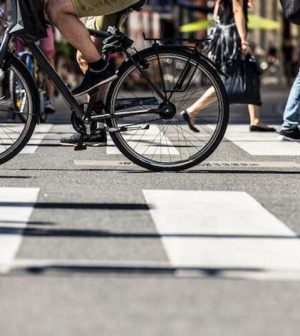- Skip Storing This Everyday Product in the Fridge Door
- Green Tea + B3 Pairing May Boost Brain Health
- Navigating Your Midlife Crisis: Embracing New Possibilities
- City Raccoons Showing Signs of Domestication
- Mapping the Exposome: Science Broadens Focus to Environmental Disease Triggers
- One Week Less on Social Media Linked to Better Mental Health
- Your Brain Changes in Stages as You Age, Study Finds
- Some Suicide Victims Show No Typical Warning Signs, Study Finds
- ByHeart Formula Faces Lawsuits After Babies Sickened With Botulism
- Switch to Vegan Diet Could Cut Your Greenhouse Gas Emissions in Half
Your City Has Its Own Microbial ‘Signature,’ Scientists Say

Each city has its individual mix of tell-tale microbes, new research shows.
“If you gave me your shoe, I could tell you with about 90% accuracy the city in the world from which you came,” said study senior author Christopher Mason, director of the WorldQuant Initiative for Quantitative Prediction in New York City.
His team analyzed microbes gathered from the air and surfaces of public transit systems and hospitals in 60 cities on six continents.
“Every city has its own ‘molecular echo’ of the microbes that define it,” said Mason, who is also a professor at Weill Cornell Medicine in New York City.
The more than 4,700 samples analyzed in the study were collected over three years as part of the first systematic worldwide catalog of urban microbial ecosystems.
As well as finding that cities have distinct microbial signatures, researchers identified a core set of 31 species that were found in most (97%) of the samples across the cities studied.
In all, more than 4,200 species of microorganisms were identified, but researchers expect further sampling to find species that have never been seen before. Their findings were published May 26 in the journal Cell.
Mason started collecting and analyzing microbial samples in the New York City subway system in 2013.
After he published his first findings, researchers from all over the world contacted him, seeking to do similar studies in their own cities.
In response, Mason developed a protocol that other scientists could use to collect samples.
In 2015, he created an international consortium that has since expanded to collecting samples from air, water and sewage in addition to hard surfaces.
“People often think a rainforest is a bounty of biodiversity and new molecules for therapies, but the same is true of a subway railing or bench,” Mason said in a journal news release.
More information
The American Museum of Natural History has more on microbes.
SOURCE: Cell, news release, May 26, 2021
Source: HealthDay
Copyright © 2025 HealthDay. All rights reserved.










